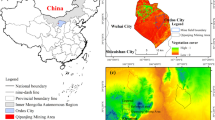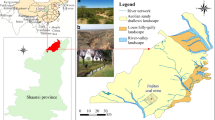Abstract
Coal mining has serious impacts on local environment, including damage to the land and soil by subsidence, damage to ground-water systems through the fracturing and subsiding of overlying rocks, contamination of surface waters with acid mine drainage, and pollution of the atmosphere by release of toxic gases. The damage to ground water and its consequent impacts on the regional environment is the core of research of the coal mining from the perspective of environment protection. The present paper focuses on the changes of surface vegetation coverage, the pollutants released from pit coal power plants, and the damages to the ground aquifers induced by mining activities in arid Eastern Junggar coalfield of China. At first, the authors investigated the changes of surface vegetation coverage, since mining began in the 2000s using Landsat data. Results show that the low surface vegetation coverage (grade 1 plus grade 2) in the southern part of the region decreased from 11.62 × 108 m2 in 2003 to 9.57 × 108 m2 in 2017 (−17.6%), while it increased from 11.58 × 108 m2 in 2003 to 12.70 × 108 m2 in 2017 (+ 9.7%) in the eastern part. The high surface vegetation coverage (grade 3 plus grade 4) in the southern part increased from 1.94 × 108 m2 in 2003 to 4.00 × 108 m2 in 2017 (+ 106.2%), while it decreased from 4.39 × 108 m2 in 2003 to 3.26 × 108 m2 in 2017 (−25.74%) in the eastern part. The data of annual precipitation during the same period in this area show that the changes of surface vegetation coverage have less relationship with the annual precipitation, which indicates that the mining activities is probably the major factor for that. Second, a statistic of air pollutants generated from pit coal power plants was made based on data of references. Results show that the estimated gaseous pollutant emissions increased as 865.23 tons of smoke particles, 5940.73 tons of SO2, and 7584.48 tons of NO2 in 2013, which increased rapidly with 9.73 times the smoke particle, 21.69 times the SO2, and 9.24 times the NO2 than that of 2007. And then, the physical and numerical simulation of the damage of mining activities to aquifers was made to show the permeability of the reference points of overlying aquifers varies associated with mining activities. Results show that the porous rock matrix permeability has a negative relationship with fluctuation during mining, while the fracture permeability shows a positive one. Finally, a case investigation in southern area surrounding this coalfield was illustrated. Result shows that the local ground-water level decreased by 16 m difference from the altitude level of + 774 m in 2003 to + 758 m in 2013. Data and results from this study presented the already and the potential pollutions and damages to local environment induced by the mining activities in this region.



















Similar content being viewed by others
References
Bahrami S, Ardejani FD, Baafi E (2016) Application of artificial neural network coupled with genetic algorithm and simulated annealing to solve groundwater inflow problem to an advancing open pit mine. J Hydrol 536(2016):471–484
Daozhong C, Qingli Z, Jie W, Xiaozhi Z (2011) Comparative analysis of ecological rucksack between open-pit and underground coal mine. Energy Procedia 5(2011):1116–1120
da Silvaa MG, Muniz ARC, Hoffmann R, Lisbôa ACL (2018) Impact of greenhouse gases on surface coal mining in Brazil. J Clean Prod 193(2018):206–216
Espitia-Pérez L, Arteaga-Pertuz M, Soto JS, Espitia-Pérez P, Salcedo-Arteaga S, Pastor-Sierra K, Galeano-Páez C, Brango H, da Silva J, Henriques JAP (2018) Geospatial analysis of residential proximity to open-pit coal mining areas in relation to micronuclei frequency, particulate matter concentration, and elemental enrichment factors. Chemosphere 206(2018):203–216
Huang L, Zhang P, Hu Y, Zhao Y (2015) Vegetation succession and soil infiltration characteristics under different aged refuse dumps at the Heidaigou opencast coal mine. Glob Ecol Conserv 4(2015):255–263
Huang L, Zhang P, Hu Y, Zhao Y (2016) Vegetation and soil restoration in refuse dumps from open pit coalmines. Ecol Eng 94(2016):638–646
Huertas JI, Huertas ME, Izquierdo S, González ED (2012) Air quality impact assessment of multiple open pit coal mines in northern Colombia. J Environ Manag 93(2012):121–129
Huisamen A, Wolkersdorfer C (2016) Modelling the hydrogeochemical evolution of mine water in a decommissioned opencast coal mine. Int J Coal Geol 164(2016):2–12
Hussain R, Wei C, Luo K (2019) Hydrogeochemical characteristics, source identification and health risks of surface water and groundwater in mining and non-mining areas of Handan, China. Environ Earth Sci 78(2019):402–422
Jie J (2015) Study on simulation of atmospheric pollution in the Economic Technological Development Zone of Eastern Junggar Basin (Thesis). Xinjiang Agriculture University, Urumqi, China
Kumari S, Maiti SK (2019) Reclamation of coalmine spoils with topsoil, grass, and legume: a case study from India. Environ Earth Sci 78(14):429. https://doi.org/10.1007/s12665-019-8446-2
Liu XY, Wei ZA, Bai ZK (2016) Vegetation coverage change and stability in large open-pit coal mine dumps in China during 1990–2015. Ecol Eng 95(2016):447–451
Reisen F, Gillett R, Choi J, Fisher G, Torre P (2017) Characteristics of an open-cut coal mine fire pollution event. Atmos Environ 151(2017):140–151
Yongjun Y, Erskine PD, Shaoliang Z, Yunjia W, Zhengfu B, Shaogang L (2018) Effects of underground mining on vegetation and environmental patterns in a semi-arid watershed with implications for resilience management. Environ Earth Sci 77(2018):605–616
Zhao L, Ren T, Wang N (2017) Groundwater impact of open cut coal mine and an assessment methodology: a case study in NSW. Int J Min Sci Technol 27(2017):861–866
Acknowledgements
This study was supported by the National Natural Science Foundation of China with grant no. 51374182 and the Department of Science and Technology of Xinjiang Province Government of China with grant no. 2018E01011.
Author information
Authors and Affiliations
Corresponding author
Additional information
Publisher's Note
Springer Nature remains neutral with regard to jurisdictional claims in published maps and institutional affiliations.
Rights and permissions
About this article
Cite this article
Zeng, Q., Shen, L. & Yang, J. Potential impacts of mining of super-thick coal seam on the local environment in arid Eastern Junggar coalfield, Xinjiang region, China. Environ Earth Sci 79, 88 (2020). https://doi.org/10.1007/s12665-020-8806-y
Received:
Accepted:
Published:
DOI: https://doi.org/10.1007/s12665-020-8806-y




